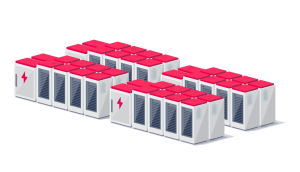Principles of Charging LiFePO4 Batteries
The next obvious step after deciding to buy LiFePO4 batteries is to figure out what additional parts your system needs. Having a charger that works with your battery is essential, among other things. It can be difficult to choose which charger is best for your Maxworld Power LiFePO4 battery. In order to tackle this difficulty, let’s examine the fundamentals of charging lithium batteries.

What occurs when a LiFePO4 battery is charged?
An external voltage is applied to a LiFePO4 battery during charging in order to drive current from the battery’s anode to its cathode. When the battery is discharged, the lithium battery charger functions as a pump, pumping current upstream and against the natural direction of current flow.
When the voltage delivered by the charger is higher than the battery’s open circuit voltage, charging current flows. The open circuit voltage of the battery rises during this process, getting close to the applied voltage of the charger.
The distinction between floating and batch charging
Throughout the charging process, lithium battery chargers can exhibit a wide range of behaviors. In order to maintain a steady current, the charger can first gradually raise the voltage. This is the initial phase of charging, sometimes known as the “bulk” charging phase. In order to provide the battery the maximum amount of current during this phase, the charger modifies the voltage it applies.
During this bulk charging phase, for instance, a 10 amp charger will deliver a maximum of 10 amps, and the applied voltage will climb to the maximum voltage, also referred to as the “bulk voltage.”
The charger moves on to the “absorption” charging stage, which is the second stage after reaching the bulk voltage. The charger applies a steady voltage known as the “absorption voltage” during the absorption process. The current gradually drops to zero when the open circuit voltage of the battery gets closer to the absorption voltage.
The battery is fully charged right now. However, if the charger is unplugged, lead-acid batteries lose charge rapidly. As a result, instead of shutting down, the battery charger goes into a third phase known as the “float” phase, during which it lowers its voltage and stays there. Keeping the battery full is the main goal of this phase because lead-acid batteries have a tendency to discharge quickly even in the absence of a load. For Maxworld Power LiFePO4 batteries, float charging is not necessary.
What algorithm is used to charge batteries?
The “charging algorithm” is the result of the sequential combination of the bulk, absorption, and floating stages. Target battery voltage (12V, 24V, 36V, 48V, etc.) and charging current (i.e., maximum charging current) are the two main categories for battery chargers. However, numerous charging algorithms (typically categorized as “AGM”, “SLA”, “gel”, “wet”, etc.) may also be included in battery chargers.
The values of lead-acid battery charging algorithms vary greatly. The usual range for the bulk, absorption, and float voltages is 14.0–14.8 V, while the float voltage is 13.2–13.8 V.
These ranges are exactly where the 12V Maxworld Power Battery falls. 14.4 V is the volume and absorption voltage that we advise. Although floating is not necessary because lithium-ion batteries do not leak, a floating voltage of less than 13.6 V is acceptable.
How are LiFePO4 batteries charged?
When selecting a device to chargeLiFePO4 batteries, compatibility is essential. The key to determining charger compatibility is making sure the charger’s specifications line up with the battery’s. Make sure your charger can deliver 14.2-14.6 Bulk/Absorb and 13.6 Float for Maxworld Power lithium batteries. If you give these particular characteristics, you can use your lithium battery with a number of chargers.
It’s important to make sure your charger has appropriate settings even though you don’t need to purchase a special charger for Maxworld Power LiFePO4 batteries. Make sure a charger can handle current between 14.2-14.6 Bulk/Absorb and 13.6 Float when assessing its compatibility. Although float charging is not necessary for our batteries, Battle Born batteries can be charged using many of the same equipment that are used to charge other battery types with similar specifications.
What is the lifespan of Maxworld power batteries?
Our lithium batteries will have 75–80% of their battery life left after 3,000 full discharge cycles in harsh environments, according to our comprehensive cycle testing. In general, after 5,000 cycles, the battery capacity will reach 75–80% for the user who does not use it in harsh conditions. Your Battle Born batteries can survive for ten to fifteen years if you properly charge and discharge them every day. You can rely on our lithium batteries to last for many years as they come with a 10-year warranty.
LiFePO4 battery charging in cold climates
After selecting a LiFePO4 battery charger that works for you, it’s critical to get your electrical system ready for any unexpected changes in weather. Some campers wish to experience the many seasons, while others choose camping near the 70th parallel. When using Maxworld Power lithium batteries in an area where subfreezing conditions are probable, make sure your system is ready ahead of time to prevent low-voltage disconnections or power outages.






